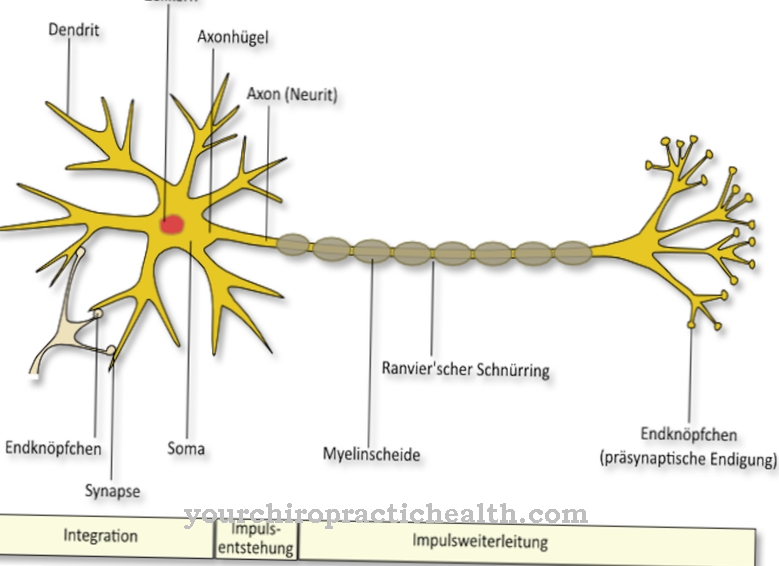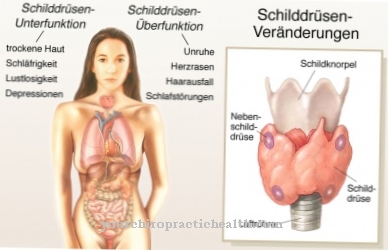Of the Temporalis muscle is a mastication muscle in humans. The skeletal muscle is at the level of the temple. It helps to close the jaw.
What is the temporalis muscle?
The temporalis muscle is a skeletal muscle that is located in the human face. It is called the temporal muscle because it extends below the temple on either side of the face. At the same time it extends down to the lower jaw.
Its job is to help close the lower jaw. A total of four muscles are counted to the masticatory muscles of the human jaw. They all have different functions in regulating the purchase process. The four muscles take on all the functions that arise, such as opening or forcefully closing the lower jaw. The mobility in all directions is controlled by them. The four muscles of mastication are the masseter muscle, the temporalis muscle, the medial pterygoid muscle and the lateral pterygoid muscle.
While the masseter muscle works very closely with the medial pterygoid muscle, the lateral pterygoid muscle and the temporalis muscle have other tasks. The temporalis muscle is responsible for the jaw closure, so that a retraction of the lower jaw is possible. Of all four masticatory muscles, the temporalis muscle is the strongest muscle in the chewing apparatus.
Anatomy & structure
The 5th cranial nerve is the trigeminal nerve. It supplies large parts of the face with its nerve branches. In addition, it is responsible for the motor skills of the chewing apparatus with its branches. The mandibular nerve in particular takes on this function.
It goes off as the second branch from the trigeminal nerve. It contains sensitive nerve fibers that, among other things, supply the face. In addition, it houses motor parts. These are further divided into several sub-branches. They include the masseteric nerve, which innervates the masseter muscle. The temporal nerves supply the temporalis muscle. The pterygoid nerves are responsible for supplying the lateral pterygoid muscle and the medial pterygoid muscle.
The last sub-branch is the mylohyoid nerve, which supplies the floor muscles of the mouth from the mylohyoid nerve. The temporal muscle begins its course at the temporal fossa. This is a bulge on the skull near the temple. The temporalis muscle spreads over a large area in a fan shape. It extends to the lower jaw of the chewing apparatus.
Function & tasks
Like all other muscles of the chewing apparatus, the temporalis muscle has an important role in the movement of the lower jaw. Its main functions are the closure of the lower jaw and the ability to move the lower jaw backwards. The masseter muscle forms a unit with the medial pterygoid muscle. They wrap around the lower jaw like a noose and thus increase their strength during the closing process. In contrast, the temporalis muscle works largely alone.
In direct comparison with the other masticatory muscles, the temporalis muscle is the strongest sphincter muscle in the masticatory apparatus. It lifts the lower jaw and thus enables the mouth to be closed. The chewing muscles play a key role in breaking up food. The movements of the jaw break the ingested food into small pieces so that digestion can take place later. It is chewed until the individual elements of the food have a size that can initiate the swallowing process. Elements that are too large make the swallowing process difficult or impossible.
Closing the lower jaw enables biting while eating. Only by closing the lower jaw can this possibility of eating take place at all. In addition, the muscles of the chewing apparatus play a key role in language formation. Without them, the sound formation required for speaking or singing would not be possible to a sufficient extent. Some sounds form only when the lower jaw is raised and lowered. The preparatory work for sound formation takes place in the larynx and the glottis. It is refined and completed by moving the jaw.
You can find your medication here
➔ Toothache medicationDiseases
Pain in the chewing apparatus is experienced by people as particularly painful. Many patients report pain attacks that are mostly related to the teeth. Teeth discomfort has a direct effect on the entire chewing system.
Misalignments, faulty dentures or inflammation of the nerves in the entire mouth and throat area cause problems when chewing. The masseter muscles are closely related to the head, neck and back muscles. As soon as there are complaints of the masticatory muscles, pain usually also occurs in the other muscles. Headaches or tension are among the most common symptoms. Others are nocturnal teeth grinding or jaw misalignment. As soon as the temporalis muscle suffers lesions, the lower jaw can no longer be moved backwards. This has a direct impact on the grinding of the food.
Furthermore, the rotary movements of the lower jaw are then no longer possible. Lesions are conceivable after accidents, fractures of the jaw or during surgery in the throat or mouth area. In addition, the impairment of the temporalis muscle can lead to changes and restrictions in language formation. The sounds can no longer be pronounced correctly if the jaw is unable to move sufficiently. This can lead to misunderstandings in everyday life and even make professional singing impossible.
























.jpg)



